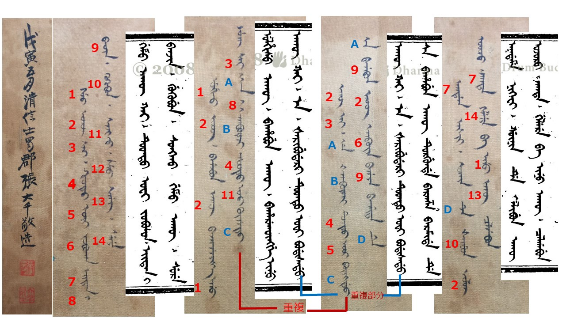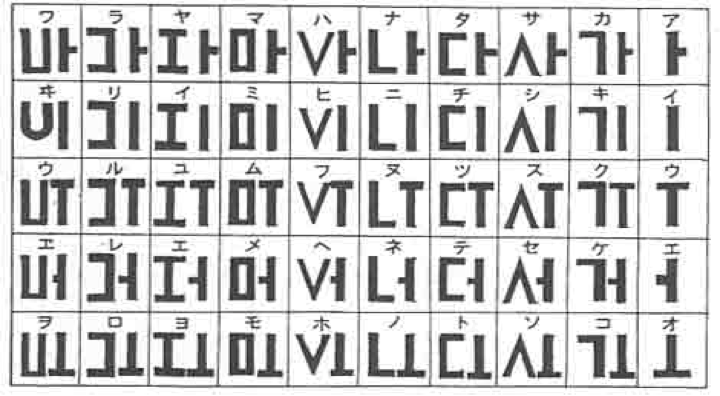Artistic Sinograph: Buddha
On the wall of an apartment complex in Dali, Yunnan, southwestern China:
Read the rest of this entry »
On the wall of an apartment complex in Dali, Yunnan, southwestern China:
Read the rest of this entry »
[This is a guest post by Denis Christopher Mair]
Regular character versions of the Yijing (Classic / Book of Changes) use the character 旡 instead of 無 for wú ("none; no; not; nothing; nihility"). So 旡 is not really a simplified character. I have seen 旡 in Daoist contexts. The character 旡 evokes an atmosphere of antiquity. Some Daoist texts have two different words for qi/ch'i ("vital energy"). One is written 氣, and the other is written with 旡 over a four-dot fire radical. (Some Daoist texts use 炁 wherever the context is about internal disciplines.) This distinction is sometimes explained by saying that 氣 is "acquired" (hòutiān 後天) energy, and 炁 is "innate" (xiāntiān 先天) energy. In Tiāndì jiào 天帝教 ("Lord of Universe Church," a religious organization in Taiwan), the phrase qì qì yīnyūn 氣炁氤氳* sometimes comes up: "the intertwining of acquired and innate energies," which is something that happens in meditation. Sometimes it is fancifully likened to ground mist mingling with low clouds.
Read the rest of this entry »
Here at Language Log we know our Ossetes and have been learning much about Scythians (see "Selected readings"), so it is good to have this new (forthcoming) book by Richard Foltz:
The Ossetes: Modern-Day Scythians of the Caucasus
New York / London: I. B. Tauris / Bloomsbury, 24 February 2022
The Ossetes, a small nation inhabiting two adjacent states in the central Caucasus, are the last remaining linguistic and cultural descendants of the ancient nomadic Scythians who dominated the Eurasian steppe from the Balkans to Mongolia for well over one thousand years. A nominally Christian nation speaking a language distantly related to Persian, the Ossetes have inherited much of the culture of the medieval Alans who brought equestrian culture to Europe. They have preserved a rich oral literature through the epic of the Narts, a body of heroic legends that shares much in common with the Persian Book of Kings and other works of Indo-European mythology. This is the first book devoted to the little-known history and culture of the Ossetes to appear in any Western language. Charting Ossetian history from Antiquity to today, it will be a vital contribution to the fields of Iranian, Caucasian, Post-Soviet and Indo-European Studies.
Read the rest of this entry »
From the Library of Congress International Collections FB page (Saturday 7/17/21):
Read the rest of this entry »
A week or so ago, we looked at the phenomenon of "lying flat" (see under "Selected readings" below).
Karen Yang writes from China:
Hahahahha, tang ping ["lying flat"] was kind of a hot topic last month, for about one week. Maybe it’s because the College Entrance Exam was on-going, people tended to talk about life attitude such as tang ping or work hard. But you know how fast the Internet in China moves on, so I wouldn’t say tang ping is a significant movement.
On the other hand, foxi (佛系) is a rather more frequently used word similar to tang ping. Basically it describes that young generations in East Asia, especially in Japan, tend to be indifferent or even negative about money, promotion, marriage, raising kids and so on, just like a Buddha. It’s an attitude in response to the heavy pressure brought by social development.
Read the rest of this entry »
[This is a guest post by Jichang Lulu]
In “Ornamental Manchu: the lengths to which a forger will go” (LL, April 24), Professor Mair discussed a handscroll with faux-Manchu inscriptions. Although the writing clearly imitated Manchu, the imitation was so liberal and the forger so unfamiliar with the Manchu script that hardly any word was intelligible even to eminent Manjurists consulted for the post.
As a non-Manjurist, I found the text only more puzzling, but was able to identify its model by comparing a a conjectural reading of a non-recurring word in it to a published text of a Manchu translation of the Heart Sutra (Fuchs, Die mandjurischen Druckausgaben des Hsin-ching (Hṛdayasūtra) (non legi), transcribed in Hurvitz, “Two polyglot recensions of the Heart Scripture”, J Indian Philos 3:1/2 (1975)). That guess I shared in a comment embedded in the post, elaborated under it with the likely source text. That presumably settled the question, but, with the source given in transliteration only, didn’t make it any easier to appreciate the hilarious cavalierness of the copy without an ability to mentally untransliterate it back into the Manchu script.
Professor Kicengge has now compared the text to a Manchu-script rendition of the sutra and composed an image that juxtaposes the copy to its model. The juxtaposition verifies the identification of the source text: not only does the text (very roughly) match, so does its division into columns.

The handscroll’s faux Manchu and its model, juxtaposed. Supplied by Kicengge.
Read the rest of this entry »
Martin Delson asked about a couple of Chinese expressions that appeared in this article from the San Jose Mercury News (6/17/21):
"China launches crew to its new space station", by Carlos Garcia and Shubing Wang
Complete, and more easily accessible version from Reuters (6/17/21):
"Chinese astronauts board space station module in historic mission", by Carlos Garcia
The three astronauts are Nie Haisheng, 56, Liu Boming, 54, and Tang Hongbo, 45.
"This will be the first crewed flight in the space station (construction) phase, and I'm lucky to be able to have the 'first baton,'" Nie told reporters in Jiuquan a day before the launch.
Wang Yaping, a member of the Shenzhou-12 backup team, told state media.
"In our crew, elder brother Nie is like the needle that stills the sea…".
Read the rest of this entry »
[This is a guest post by Bob Ramsey]

Writing from the Age of the Gods (Jindai moji)
Read the rest of this entry »
[This is a guest post by Mark Metcalf, who makes no claim to having any language proficiency with New Testament Greek.]
Read the rest of this entry »
An anonymous collector recently sent me photographs of a handscroll featuring eight manifestations of Guanyin (Skt. Avalokiteśvara), the Bodhisattva of Compassion painted on silk, circa 1940s. A striking feature of this handscroll is that each painting of one of the manifestations is accompanied by a vertical Manchu inscription on the upper right side. The Manchu writing looks genuine, but it has some characteristics that give one pause. The paintings also have some aspects that are disquieting. In this post, l will reproduce only the first and last paintings, but will also provide some other illustrations for comparative purposes.
Read the rest of this entry »
From Bryan Van Norden:
I found interesting these paired poems by the 15th-century Japanese Zen monk Ikkyū (1394-1481) and by his mistress, the blind singer Mori. He writes his poem in Classical Chinese, because he is a man, but her poem is in hiragana, because she is a woman. Below are photos of the original scroll, showing paintings of Ikkyū and Mori, from Arntzen's translation, and a more recent translation by Messer and Smith. I am researching Ikkyū for what will ultimately be a five-minute segment in my class lecture on Zen this week. I find that students have trouble appreciating what is at stake in the debate over metaphysical monism vs dualism. Ikkyū, a monk who frequented bars and brothels, shows one way of rejecting dualisms (like sacred vs profane, mind vs. body, monk vs. layperson).
Read the rest of this entry »
A friend called my attention to this intriguing article:
"This man can read and write 30 ancient Indonesian scripts, some as old as 500 years", by Kiki Siregar, Channel NewsAsia / CNA (3/6/21)
Thirty years old Diaz Nawaksara says, “I started in 2012 by studying the Javanese script first.”
Today, he can read and write over 30 ancient Indonesian scripts. He understands fluently about half of the languages associated with these scripts.
It is a rare ability considering that most Indonesians can only read one or two scripts.
Most Indonesians can read Latin, the script used for the national language Bahasa Indonesia as well as English. Others also know Arabic for reading the Koran or Chinese.
Read the rest of this entry »
[This is a guest post by Nicholas Morrow Williams]
It's obvious when you think about it, but of course there was originally no need to write the word hanzi when Chinese characters were the only game in town, writing-wise. Wang first refers to some earlier identifications of the earliest use of hanzi dating to the Song (960-1279) or Yuan (1271-1368), and then points out that the Japanese monk-scholars Kūkai 空海 (774-835) and Saichō 最澄 767-822) seem to have used it in their works, though the details are a bit complex. The clearest single usage seems to be in a text completed by Saichō in 818, entitled the Jugokoku kaishō 守護国界章. But then Wang further points out the Fànyǔ qiānzì wén 梵語千字文 by Yijing 義浄 (635-713), which explains in its introduction that it uses hanzi in correspondence to each Sanskrit letter. The overall point is clear: the term hanzi first came into common usage among Tang-era (618-907) monks as it was required to distinguish Chinese writing from Sanskrit. This insight does not seem to have been incorporated into all the standard reference works yet (my Hanyu da cidian identifies the earliest usage in the Song).
Read the rest of this entry »